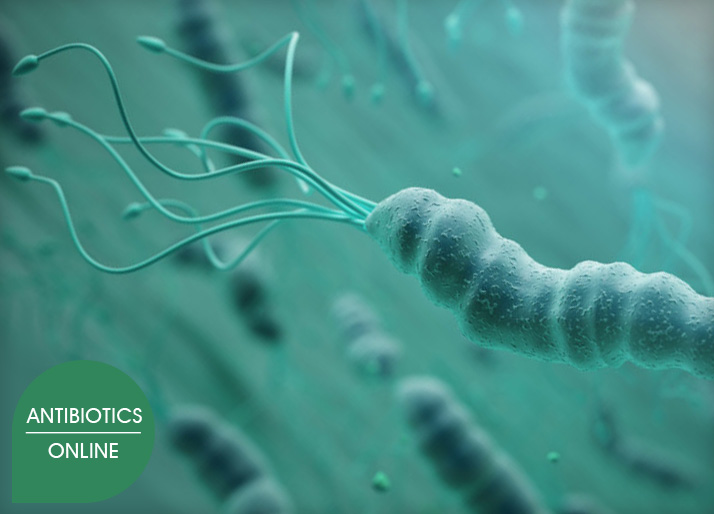Helicobacter pylori
Helicobacter pylori is a member of the Helicobacter family of bacteria found in the digestive tract.
Helicobacter pylori lives only in the human stomach. It takes its name from its spiral shape, and is equipped with 2 to 6 flagella that enable it to travel on the mucus that covers the stomach wall.

It seems impossible that a living organism such as a bacterium could live in a highly acidic environment like that of the stomach, and that's what scientists thought until 1982.
It was then that two Australian researchers, John Robin Warren and Barry Marshall, first identified and cultivated an unknown bacterium nestling in the stomach lining of several ulcer patients: Helicobacter pylori. They hypothesized that this bacterium might be responsible for stomach disorders such as ulcers.
This hypothesis has since been confirmed, as stomach ulcers are now considered to be diseases caused by Helicobacter pylori infection and, like all infectious bacterial diseases, are treated with antibiotics. For this discovery, the two researchers were awarded the 2005 Nobel Prize in Medicine.
In the stomach, Helicobacter pylori protects itself from acidity by secreting a urease enzyme which neutralizes gastric acidity. The bacterium can then survive and proliferate in the mucus of the stomach lining.
This inflammation, known as chronic gastritis, generally evolves without any particular symptoms, but persists for as long as the bacteria are present, sometimes for life.
Subsequently, gastric lesions linked to Helicobacter pylori infection, such as ulcers or gastric cancer, can sometimes develop. These lesions build up over several years and evolve slowly: it can sometimes take more than 30 years before symptoms appear!
Who is infected?
Today, it is estimated that almost 50% of the world's population is infected with Helicobacter pylori. This is the most widespread chronic bacterial infection in humans after dental caries.
The rate of infection varies according to a number of criteria, including age, geographical origin and living conditions. The mode of infection is in fact linked to promiscuity, which constitutes a favorable terrain for person-to-person transmission.
Helicobacter pylori infection generally occurs in childhood. It usually goes undetected, and persists for the rest of a person's life, often without any notice or consequences.
In developing countries, infection is acquired very quickly, due to poor hygiene and promiscuity: it is estimated that 80% of the population is affected before the age of 20.
By contrast, in developed countries, 1 in 5 adults is infected by the age of 20.
In France, 5 to 10% of children are infected, and infection is rare before the age of 4. This figure rises to 20-50% in adults. After the age of 60, nearly one in two is infected.
With the improvement in living conditions and hygiene in developed countries, infection is less frequent in new generations than in older ones.
In Europe, migrants are more frequently infected than their native populations, and the rate of infection is higher when the socio-economic level is low.
Although the number of infections is very high, most (80%) of those infected will not develop symptoms.
How do you get infected?
Helicobacter pylori is the species native to humans, and lives only in the human stomach. Transmission is human-to-human. Certain animals have been incriminated, but their role has never been confirmed. In fact, animals have their own Helicobacter flora colonizing their digestive tract.
Infection occurs in childhood. Theoretically, humans can be contaminated in two ways: orally or through their feces. Transmission of the bacterium is essentially by direct person-to-person oral-oral and, above all, gastro-oral transmission. In other words, contamination occurs through direct contact with infected saliva during regurgitation or vomiting.
Transmission via the stool, following contact with hands or contaminated food or water, is rarer and occurs more frequently in developing countries where hygiene is poor.
The mode of transmission implies proximity, which is why Helicobacter pylori is most often transmitted within the same family, particularly in the parent-child direction, or between children, as the latter are more susceptible.
Once the bacterium has entered the stomach, it continues to proliferate throughout life until eradicated by appropriate treatment.
Factors favoring the transmission of infection include communal living, the sharing of cutlery, or the habit of chewing food given to infants.
Factors linked to poor socio-economic conditions and hygiene are also decisive: absence of toilets in the home, lack of running water, poor hand hygiene after using the toilet, etc.
What diseases are associated with H. pylori?
Stomach pain can have many causes.
In the case of sudden onset of pain accompanied by vomiting and diarrhoea, food poisoning or gastroenteritis are evoked, and the responsibility of a virus or bacteria is suspected in this context.
But if the pain is chronic, there may also be damage to the stomach caused by a bacterium: Helicobacter pylori.
Chronic inflammation of the stomach
The bacterium causes chronic gastritis in the infected person, which persists for life if the infection is left untreated. In most cases, it evolves silently, with no particular symptoms or manifestations.
A revolution in the management of stomach and duodenal ulcers
The responsibility of Helicobacter pylori in the genesis and maintenance of ulcers is now well established. In the stomach, Helicobacter pylori is responsible for 7 out of 10 ulcers. The duodenum is the part of the intestine immediately following the stomach, and 9 out of 10 duodenal ulcers are linked to Helicobacter pylori. Since this discovery, treatment of the infection by eradicating the bacteria not only cures the ulcer, but also prevents frequent relapses.
Precautions should be taken with certain medications. Indeed, in the event of Helicobacter pylori infection, taking certain medications such as non-steroidal anti-inflammatory drugs or aspirin may increase the risk of ulcer or bleeding.
Helicobacter pylori, responsible for stomach cancer
As early as 1994, the International Agency for Research on Cancer classified Helicobacter pylori as a class I carcinogen, i.e. a definite risk of cancer in humans. It is now estimated that the bacterium is responsible for 60-90% of gastric cancers. In this way, Helicobacter pylori could be responsible for more deaths per year than road accidents, since gastric cancer is particularly deadly.
However, not all infected subjects will develop gastric cancer, far from it: 1 to 3% of infected subjects could develop gastric cancer. It takes several years to reach this final stage, sometimes even more than 30 years. Getting rid of the infection avoids this progression, especially if this is done early before lesions appear.
As there is a family predisposition to gastric cancer, it is strongly recommended that children and siblings of people who have had stomach cancer should be tested for Helicobacter pylori infection, and treated if necessary.
In addition to family predisposition, there are a number of other factors that can contribute to the development of cancer:
- smoking
- over-consumption of salt, as well as a diet rich in brines (smoked meat or fish in particular), red meat...
- certain environmental factors (exposure to nitrates and nitrites),
- certain more virulent strains of Helicobacter pylori.
Helicobacter pylori responsible for other pathologies?
Numerous ongoing studies are looking for potential links between Helicobacter pylori and other conditions, such as dyspepsia or even non-digestive diseases. For the time being, some people may experience a benefit on their symptoms by ridding themselves of the infection, while others may not. Migraines, Parkinson's disease, cardiovascular pathologies and certain immune disorders have all been linked to Helicobacter pylori infection, although these hypotheses have yet to be confirmed.
How do I know if I'm infected?
Repeated stomach pains are signs to be taken seriously, and it's always a good idea to talk to your doctor, especially if a family history suggests a particular tendency towards gastric ulcers and/or cancer.
There are several methods for diagnosing the infection.
A gastric fibroscopy may be performed depending on the symptoms and the context, and especially if the doctor deems it useful. It allows direct visualization of the inside of the stomach and duodenum, and also allows the detection of Helicobacter pylori through a short test and laboratory analysis of the small fragment taken from the stomach wall. During the 6 hours preceding the examination, you must fast (neither eat nor drink) unless otherwise advised by your doctor. You must also refrain from smoking.
Helicobacter pylori is easily detected, thanks to a specific enzyme it produces: urease. A rapid diagnostic test can therefore be performed in parallel with fibroscopy on the sample taken: the urease test.
When a fibroscopy is not necessary, there are also non-invasive means of testing for the bacterium.
These include testing stools for Helicobacter pylori antigens, testing blood samples for antibodies to the bacterium, or performing a breath test. The latter is easily performed in a medical analysis laboratory: after ingesting a “revealing” liquid (urea diluted in a glass of water), simply blow into a tube, and the analysis of the exhaled air will indirectly detect the presence of Helicobacter pylori. For this test, you must not have taken any antibiotic treatment for at least 4 weeks, and must have stopped any treatment against gastric acidity for at least 2 weeks. In addition, you must be fasting: i.e. you must not have eaten, drunk or smoked since the evening before.
How can I treat myself?
If the bacterium is detected in the stomach, it can be eradicated with a short course of treatment (1 to 2 weeks), which is simple and effective in 90% of cases.
Since Helicobacter pylori is a bacterium, it needs to be treated with a combination of antibiotics, accompanied by a medication to combat gastric acidity for the duration of the treatment.
A control test is then carried out to ensure that the bacteria have disappeared from the stomach. The reference method for this control is the respiratory test, if fibroscopy is not necessary. Serology cannot be used in this case, as the antibodies that testify to the infection may persist for several weeks.
This control is necessary because the bacteria may not be eliminated after the first treatment. This may be due to the bacterium's resistance to the antibiotics used, or to poor or inadequate treatment. It is therefore important to scrupulously adhere to the treatment prescribed by the doctor.
In the event of failure, new combinations of antibiotics may be recommended.
Eradication of Helicobacter pylori halts the evolution of stomach lesions, whatever the patient's age. The benefit is therefore real, even if the patient has been infected for many years. As far as stomach cancer is concerned, there is a benefit to treatment, especially if it is carried out at an early stage before lesions appear.
Once the bacteria have been eradicated, reinfection is extremely rare. Treatment can therefore be considered definitive.

